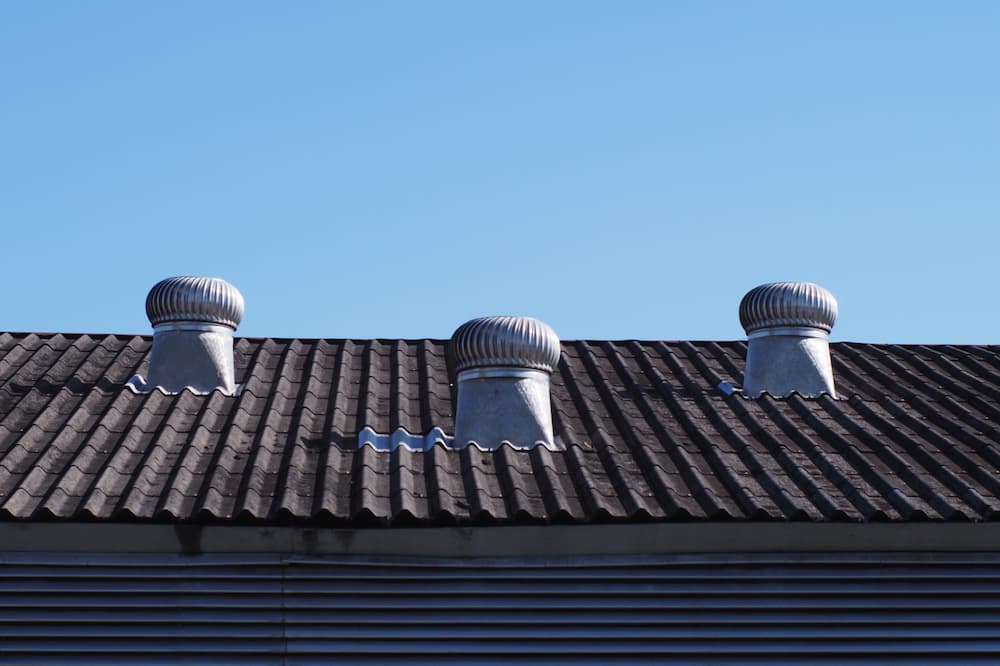Roof Space ventilation is required by the building code and is essential for maintaining the health and longevity of your roof. Whether you have an attic below a pitched roof, or a vented ceiling cavity in a ‘flat’ roof, the minimum net free area of ventilation is 1 square foot for every 150 square feet of space requiring ventilation. The code allows this to be reduced to 1:300 when a vapor barrier is properly installed and certain restrictions on ventilator type and placement are met. Roof vents allow hot air and moisture to escape, preventing them from becoming trapped and causing problems within the roof structure.
Albuquerque (along with much of the rest of New Mexico) experiences diverse weather conditions throughout the year. Therefore, ensuring your roof has adequate ventilation is even more critical. At National Roofing, we understand the significance of properly ventilated roof spaces.
Keep reading to understand the different roof vents options available for ventilation and which fits your roofing needs best.
The Most Common Types of Roof Vents
Roof vents play a crucial role in facilitating air circulation, which directly effects roof health. Here are the most common ventilation types:
1. Ridge and Off Ridge Vents (used at pitched roofs)
Ridge vents are installed along the roof’s peak, allowing warm air to escape from the roof space. Off-ridge, off-peak, or box vents are static vents installed just below the roof’s ridge. They provide continuous ventilation without the need for electrical power, and are often considered the most effective exhaust vents when used in conjunction with soffit vents to create a balanced airflow.
2. Hard-Wired Powered Vents
Powered vents are also used in attic spaces and are equipped with electric fans that actively exhaust hot air from the roof space. These vents are particularly beneficial in areas with high humidity or limited natural airflow. Powered vents require electrical connections for operation.
3. Roof Turbines (aka Whirlybird Ventilation)
Roof turbines are wind-driven vents that use the force of the wind to create a suction effect, pulling air out of the roof space. As the wind blows, the turbine spins, expelling hot air and promoting air circulation. Roof turbines are a popular choice in areas with consistent wind patterns.
4. Breather Vents and Moisture Relief Vents (used at low slope roofs)
Breather Vents can be installed on the roof surface to promote air flow between the roof deck and the ceiling cavity of low slope roofs. A one-way valve is designed in the unit that allows exhaust to escape and air to move between the vents, but prevents moisture from re-entering the roof system.
Moisture Relief Vents are a similar type of vent, but specifically designed to be used between two different roof coverings to evacuate moisture that might get trapped between the roofing layers.
5. Parapet Wall Vents
Wall vents are commonly used for providing air flow to low slope roof spaces through the parapet walls. For this type of vent to work effectively, proper framing methods must be used to allow the air to travel between multiple wall studs and roof joists. Vents with a louvered face have a protected bottom edge to help prevent moisture from entering the vent by way of snow or wind-driven rain.
What Happens If My Roof Doesn’t Have Proper Venting?
Inadequate ventilation can lead to a range of problems for your property. Without proper venting, excessive heat and moisture can accumulate in the roof space, causing issues such as:
- Heat buildup: Poor ventilation traps hot air in the roof, which can result in increased energy costs and discomfort in the living or working spaces below. It can also lead to premature deterioration of roofing materials.
- Moisture problems: Insufficient ventilation can cause condensation in the roof, leading to mold and mildew growth. Excessive moisture can also damage the insulation and structural components of the roof.
- Ice dams: In colder climates, inadequate ventilation can contribute to the formation of ice dams. Ice dams occur when warm air from the roof melts snow on the roof, which then refreezes at the eaves, potentially causing water damage to the roof and interior of the building.
To prevent these issues and ensure the longevity of your roof, it’s essential to have proper ventilation.
Which Type of Vent is Best for My Roof?
Every home is different, requiring different types of vents. The right type of vent for your roof depends on your home’s architectural style, the roof’s design, local climate, and personal preferences. You can consult a professional roofing contractor to help you determine the most suitable roof vent option for your specific needs.
National Roofing is Here for Your Roofing Needs
At National Roofing, we have provided high-quality roofing solutions to residential and commercial clients in Albuquerque, NM, for over 40 years. Our experienced team understands the importance of proper roof space ventilation. We can guide you in selecting the best type of roof vent for your property.
Request a roof walk today and experience our professional expertise firsthand. If there is an emergency: Call our 24/7 Emergency Support Team Now!
Featured Image Credit: Pollavich/Shutterstock

